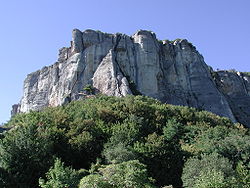
Calcarenite is a type of limestone that is composed predominantly, more than 50 percent, of detrital (transported) sand-size (0.0625 to 2 mm in diameter), carbonate grains. The grains consist of sand-size grains of either corals, shells, ooids, intraclasts, pellets, fragments of older limestones and dolomites, other carbonate grains, or some combination of these. Calcarenite is the carbonate equivalent of a sandstone. The term calcarenite was originally proposed in 1903 by Grabau[1][2] as a part of his calcilutite, calcarenite and calcirudite carbonate classification system based upon the size of the detrital grains composing a limestone.[3][4] Calcarenites can accumulate in a wide variety of marine and non-marine environments. They can consist of grains of carbonate that have accumulated either as coastal sand dunes (eolianites), beaches, offshore bars and shoals, turbidites, or other depositional settings.[3][5]
References[edit]
- ^ Grabau, A.W. (1903) Paleozoic coral reefs. Geological Society of America Bulletin. vol. 14, pp. 337-352.
- ^ Grabau, A.W. (1904) On the classification of sedimentary rocks. American Geologist. vol. 33, pp. 228-247.
- ^ a b Flügel, E. (2010) Microfacies of Carbonate Rocks, 2nd ed. Springer-Verlag Berlin, Germany. 976 pp. ISBN 978-3-540-22016-9
- ^ Neuendorf, K.K.E., J.P. Mehl, Jr., and J.A. Jackson, J.A., eds. (2005) Glossary of Geology (5th ed.). Alexandria, Virginia, American Geological Institute. 779 pp. ISBN 0-922152-76-4
- ^ Scholle, P.A., D.G. Bebout, and C.H. Moore (1983) Carbonate Depositional Environments. Memoir no. 33. Tulsa, Oklahoma, American Association of Petroleum Geologists. 708 pp. ISBN 978-0-89181-310-1
See also[edit]
- Calcilutite – Limestone that is composed of predominantly clay-size or clay and silt-size grains
- Calcisiltite – Type of limestone
- Calcirudite – sedimentary rock
Well, that’s interesting to know that Psilotum nudum are known as whisk ferns. Psilotum nudum is the commoner species of the two. While the P. flaccidum is a rare species and is found in the tropical islands. Both the species are usually epiphytic in habit and grow upon tree ferns. These species may also be terrestrial and grow in humus or in the crevices of the rocks.
View the detailed Guide of Psilotum nudum: Detailed Study Of Psilotum Nudum (Whisk Fern), Classification, Anatomy, Reproduction